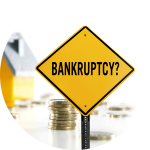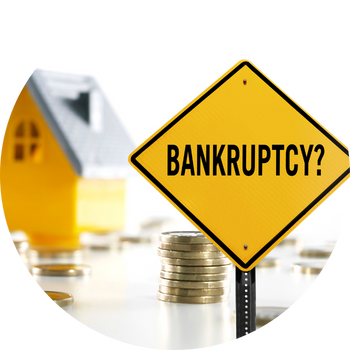
Quick Guide to Bankruptcy
In Triage Health's free Quick Guide to Bankruptcy, you'll learn about the different kinds of bankruptcy (Chapter 7 and Chapter 13), things that bankruptcy cannot do, tips when you're considering bankruptcy, and how to find an attorney in your area.
What is bankruptcy?
Bankruptcy is a federal court process that helps individuals and businesses eliminate their debts or repay them under the protection of the bankruptcy court. There are two types of bankruptcy that individuals typically file, Chapter 7 and Chapter 13.
What is the difference between Chapter 7 and Chapter 13?
Chapter 7 bankruptcy, also called “straight” or “liquidation” bankruptcy, wipes out most types of debt, and in return, you sell (liquidate) your nonexempt property in order to pay your creditors.
In a Chapter 13 bankruptcy, you use your income to pay some or all of what you owe to your creditors over time – from three to five years, depending on the size of your debts and income. In return, you may keep your property. The repayment plan describes in detail how (and how much) you will pay for each of your debts. In order for your bankruptcy to go forward, the court must approve your repayment plan and also determine that you have enough income to meet your payment obligations under the plan.
There are a few important differences between the two types of bankruptcy:
| Chapter 7 | Chapter 13 | |
|---|---|---|
| Who Can File | Liquidation | Reorganization |
| How Long Does It Take to be “Debt Free”? | Typically 3 to 5 months | Upon completion of all plan payments (usually 3 to 5 years) |
| What Happens to Property in Bankruptcy? | You can sell all nonexempt property to pay creditors | You keep all of their property but must pay unsecured creditors an amount equal to value of nonexempt assets |
| Benefits | Allows you to quickly discharge most debts and get a fresh start | Allows you to keep your property and catch up on missed mortgage, car, and other priority debt payments |
| Drawbacks | You can sell nonexempt property. Does not provide a way to catch up on missed payments to avoid foreclosure or repossession | Must make monthly payments for 3 to 5 years. May have to pay back a portion of general unsecured debts (e.g., credit cards) |
What types of debts can be discharged in Chapter 7 bankruptcy?
Credit Card Debt – Since credit card debt is considered nonpriority unsecured debt, any outstanding balance remaining after you complete your repayment plan is discharged.
Medical Bills – Medical debt is one of the main reasons people file for bankruptcy relief. If you had to incur debt because your medical care was not fully covered by insurance, you can discharge your medical bills.
Personal Loans – Similar to credit card debt, any personal loans you took out also get discharged at the end of your bankruptcy. However, keep in mind that if you pledged an asset as collateral when you took out the loan, bankruptcy may discharge your personal liability on the loan but the creditor can usually repossess the collateral if you don’t pay.
Older Tax Obligations – Most tax obligations are nondischargeable priority debts. However, certain taxes (such as older income tax obligations) may be considered nonpriority debts and get discharged upon completion of your case if you timely filed your returns and did not commit fraud.
What bankruptcy cannot do:
Prevent a secured creditor from repossessing property – A bankruptcy discharge does not eliminate liens. So, if you have secured debt (i.e., a debt where the creditor has a lien on your property and can repossess it if you don't pay), bankruptcy can eliminate the debt, but a creditor can still repossess the property.
Eliminate child support and alimony obligations – Child support and alimony obligations survive bankruptcy. You will continue to owe these debts in full, just as if you had never filed for bankruptcy. If you file for Chapter 13, your plan will have to provide for these debts to be repaid in full.
Wipe out student loans, except in very limited circumstances – Student loans can be discharged in bankruptcy only if you can show that repaying the loan would cause you “undue hardship,” a very tough standard to meet. You must be able to show not only that you cannot afford to pay your loans now, but also that you have very little likelihood of being able to pay your loans in the future.
Eliminate most tax debts – Eliminating tax debt in bankruptcy is not easy, but it is sometimes possible for older debts for unpaid income taxes.
Eliminate other “nondischargeable” debts – Nondischargeable debts, under either Chapter 7 or Chapter 13 bankruptcy, include:
- debts you fail to list in your bankruptcy filing,
- debts for personal injury or death caused by intoxicated driving, and
- fines and penalties imposed for violating the law, such as traffic tickets and criminal restitution.
Tips for considering bankruptcy:
 Assess your finances – Know what your expenses, income, and total debts are.
Assess your finances – Know what your expenses, income, and total debts are.
Pull your free credit report – Go to AnnualCreditReport.com to get an accurate list of all creditors you owe. Make sure your report is correct. If you don't include all creditors on bankruptcy filings you run the risk of going through the entire process and still owing thousands in debt.
Inform all debt collectors and creditors – Bankruptcy law requires that all debt collection calls, letters, and efforts to reach debtors cease once a bankruptcy petition is successfully filed in court.
Get a credit counseling certificate – Before you can file for bankruptcy you must get a certificate of successful completion of credit counseling with a government-certified counseling agency.
Get an attorney – Bankruptcy laws have become so complex that experts say consumers should not attempt to file by themselves.
How to find an attorney in your area:
Group legal plans – Does your employer provide a group legal plan or do you pay a monthly fee for a legal plan? If so, check to see if the plan covers bankruptcies.
State, county, or local bar associations – Many bar associations maintain a lawyer referral service, which will match you up with a few attorneys who practice in your geographical area and have experience with your type of legal issue.
Internet directories – Private companies provide directories of bankruptcy lawyers online:
Nonprofit legal services – If you have a low income, you might qualify for help from a nonprofit legal services organization. While most legal aid organizations do not provide bankruptcy representation, they may be able to help you through the process. You can find legal aid organizations at Law Help.
Law school legal clinics – Many law schools sponsor legal aid clinics and provide free legal advice to consumers. Some legal clinics have the same income requirements as nonprofit legal aid organizations. Others may provide information and services to people with slightly higher incomes.
Learn More
For more information about legal assistance, see our Quick Guide to Legal Assistance.
Sharing Our Quick Guides
We're glad you found this resource helpful! Please feel free to share this resource with your communities or to post a link on your organization's website. If you are a health care professional, we provide free, bulk copies of many of our resources. To make a request, visit TriageHealth.org/MaterialRequest.
However, this content may not be reproduced, in whole or in part, without the express permission of Triage Cancer. Please email us at TriageHealth@TriageCancer.org to request permission.
Last reviewed for updates: 01/2022
Disclaimer: This handout is intended to provide general information on the topics presented. It is provided with the understanding that Triage Cancer is not engaged in rendering any legal, medical, or professional services by its publication or distribution. Although this content was reviewed by a professional, it should not be used as a substitute for professional services. © Triage Cancer 2023
